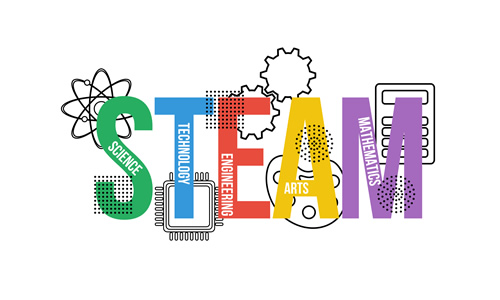As educators, our goal is to shape our students’ lives by teaching them in ways that produce well rounded individuals. Whether STEAM education is new to you or you’re already familiar with it, it’s a great way to excite students about learning.
Some people like to debate STEM vs. STEAM. In case you’re unfamiliar with these terms I’ll tell you what they mean. STEM is an acronym for Science, Technology, Engineering, & Math. STEAM is all of those, plus the A for Arts. I once had an actual rocket scientist (he’s a genius & a truly brilliant man) debate STEM vs. STEAM with me. He said there is no place for art in STEM education. Well, I disagree!
When you look at a beautiful building or a breathtaking bridge, do you not see the artistic value? When engineers design something, I have to think that they take the aesthetics of their design into account to produce something unique and beautiful!
Related content: 5 ways STEAM education is used in storytelling
I believe that it is important for our youngest learners in the elementary setting to be exposed to all subjects, and STEAM education is an excellent way to accomplish that goal. Here are 5 simple ways you can incorporate STEAM into the elementary school classroom.
1. Incorporate Children’s Literature: Using children’s literature–more specifically, picture books–is a great way to fuse STEAM into your classroom! There are so many wonderful books that help students think creatively. Some of my favorites are: The Little Red Fort by Brenda Maier, The Dot by Peter H. Reynolds, and Rosie Revere, Engineer by Andrea Beaty. These books not only inspire students of all ages, but they also let them know that it’s okay to think differently! These books lend themselves to wanting to create something that highlights their thinking and then show off their creations to their classmates!
2. Plan Integrated Lessons: This way of teaching was commonplace in the 1990s but has gone by the wayside. However, if you are able to plan a themed unit, it’s easy to incorporate STEAM education into your teaching this way. Let’s say you need to teach science standards about weather. In addition to great weather books, you can also have students work on STEAM projects such as creating a cloud in a jar, water cycle in a bag, make your own weather station, etc. By combining the principles of STEAM, you’ve shown students how their learning has real world applications, instead of teaching ideas in isolation. Completing these STEAM lessons show students how science, technology, engineering, art, and math actually go hand-in-hand and don’t have to be thought of as entirely separate entities.
3. Coding: If you’ve never taught coding in your classroom because it seems daunting, you’re not alone! Using this type of computer programming language doesn’t mean you need any fancy training–it just means that you can introduce the basics to your students. Making use of sites like Code.org (a nonprofit started by twin brothers Hadi and Ali Partovi to teach students how to code and expand access to coding to underrepresented groups) is a game-changer! Host an Hour of Code event in your classroom to increase excitement among students during Computer Science Education Week (usually held in December each year.) Students will keep coming back to these coding tutorials and games, and while they think they’re just having fun, they are actually learning the foundations of coding.
4. Discovery Education Experience STEM Career Videos: The videos and resources housed within Discovery Education’s STEM Careers channel are wide-ranging and comprehensive. These videos allow students to gain a deeper understanding of how they can incorporate the 5 pillars of STEAM into their future career. Of course there are videos on engineers and biologists, but there are also careers highlighted that you wouldn’t normally think of such as being a chef, coding at Facebook, and designing video games. Students will love seeing these videos and may even be inspired to follow a certain path that plays on their strengths.
5. Create a Maker Space: There is a maker-movement in cities all across the world! People all over the globe are tinkering, designing, and creating things–all sorts of things–that can be shown off in a maker space. These maker spaces are a place where people can access various materials to help make their dream creations a reality. Students have created everything from simple circuits, and junk-bots (robots made out of well, junk), to hydraulic arms, and pieces of art. Collecting items and organizing a maker space in your classroom is easier than you think! Your students will love being able to freely design and tinker without the pressure of being forced to create the same things as each other.
Oftentimes we feel like things keep getting added to our plate–between meetings, paperwork, and adapting to teaching remotely, we are simply overwhelmed. As teachers, we are masters at juggling a million things at the same time. Easing into STEAM education is a great way to start- try out a thing or two, then reflect on how it went.
STEAM education is not going away anytime soon, so we should probably get comfortable with it now. It’s only one more thing to add at the moment, which brings us up to a million and one things to juggle.
- How AI can unleash student curiosity, creativity, and critical thinking - November 12, 2024
- 3 keys to making math engaging - November 12, 2024
- Enhancing media literacy skills in the age of AI - November 8, 2024


